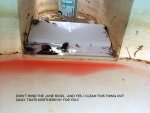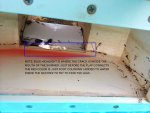Hi All,
I recently purchased a home with a pool, details are in my signature. As a DIY-er I of course searched for a forum on such a big piece of equipment that requires maintenance. For me I usually find a community on my current project car, my home, and of course (now) my pool. The big ones!
For the most part I am comfortable with the general pool knowledge and maintenance needs. I am probably bad with the correct terminology and could use a lesson or two on the more advanced aspects of things. I more or less wanted to introduce myself and let people know I'm new here. I'm sure the future will bring many questions to mind. I enjoy hearing other people's opinions on things, especially those with a lot of experience or experts on the subject... even if opinions differ, I like the whole store/360 view.
That being said, I wanted to start off with two questions for the folks around here to give me their opinions on.
1) First opening my pool two weeks ago and I've been plagued with a leak. Alas, it happens and instead of panicking I did what I do best and tried to troubleshoot (I'm an IT person so I have some experience in this area). I would lose about 4 inches in a 24 hour period, but the facts always stayed the same. The water level would drop to just below the skimmer housing. This led me to believe the leak was in/on/around the skimmer. After days of troubleshooting with/without the pump on and w/ a plug in the skimmer bottom I think I found the leak. Turns out, after careful inspection the water in the skimmer wouldn't drain... it would drain to the bottom of the skimmer level... and so when I got down in there I noticed a crack along the door/flap of the skimmer. From what I can ascertain via Google and my local pool shop (they seem like good knowledgable guys) is that this should be a fairly easy fix with special epoxy made for this type of patch. Anybody have experience with this type of crack and should I expect good results from a patch? I'm hoping it will work as I know to replace the entire skimmer it will be quite a job $$-wise and in just purchasing this home we aren't rolling in dough. I've attached a few photos of the crack.
2) Hopefully a simple question. Obviously the better test kits are preferable because of all the levels they give. I might already know the answer to this based on the type of community this is... but, are there really strong opinions against using basic test strips? During my first two weeks (at least while I kept my water level up continuously) I had crystal clear water and the test strips were all in the preferable ranges. My alkalinity started high (we have hard water and I was filling quite a bit from our hose) and with a few adjustments with dry acid it was down to normal. The rest I used an opening kit that contained stabilizer and algaecide. Basic granular shock and then a second shock with plain old bleach (seems much more effective both in cost and as a sanitizer, thanks for that tip I got from this forum!). Long story short, I feel comfortable with my water looks/quality and the strips worked out. So unless I have any problems is it okay to use the strips... or are you guys dead bent on getting a good kit (or bringing water to my store)? If so, why?
Thanks all, I know it was long winded, which probably isn't preferable, but alas it was more of an introduction than a real dead-bent question!
Tyler


I recently purchased a home with a pool, details are in my signature. As a DIY-er I of course searched for a forum on such a big piece of equipment that requires maintenance. For me I usually find a community on my current project car, my home, and of course (now) my pool. The big ones!
For the most part I am comfortable with the general pool knowledge and maintenance needs. I am probably bad with the correct terminology and could use a lesson or two on the more advanced aspects of things. I more or less wanted to introduce myself and let people know I'm new here. I'm sure the future will bring many questions to mind. I enjoy hearing other people's opinions on things, especially those with a lot of experience or experts on the subject... even if opinions differ, I like the whole store/360 view.
That being said, I wanted to start off with two questions for the folks around here to give me their opinions on.
1) First opening my pool two weeks ago and I've been plagued with a leak. Alas, it happens and instead of panicking I did what I do best and tried to troubleshoot (I'm an IT person so I have some experience in this area). I would lose about 4 inches in a 24 hour period, but the facts always stayed the same. The water level would drop to just below the skimmer housing. This led me to believe the leak was in/on/around the skimmer. After days of troubleshooting with/without the pump on and w/ a plug in the skimmer bottom I think I found the leak. Turns out, after careful inspection the water in the skimmer wouldn't drain... it would drain to the bottom of the skimmer level... and so when I got down in there I noticed a crack along the door/flap of the skimmer. From what I can ascertain via Google and my local pool shop (they seem like good knowledgable guys) is that this should be a fairly easy fix with special epoxy made for this type of patch. Anybody have experience with this type of crack and should I expect good results from a patch? I'm hoping it will work as I know to replace the entire skimmer it will be quite a job $$-wise and in just purchasing this home we aren't rolling in dough. I've attached a few photos of the crack.
2) Hopefully a simple question. Obviously the better test kits are preferable because of all the levels they give. I might already know the answer to this based on the type of community this is... but, are there really strong opinions against using basic test strips? During my first two weeks (at least while I kept my water level up continuously) I had crystal clear water and the test strips were all in the preferable ranges. My alkalinity started high (we have hard water and I was filling quite a bit from our hose) and with a few adjustments with dry acid it was down to normal. The rest I used an opening kit that contained stabilizer and algaecide. Basic granular shock and then a second shock with plain old bleach (seems much more effective both in cost and as a sanitizer, thanks for that tip I got from this forum!). Long story short, I feel comfortable with my water looks/quality and the strips worked out. So unless I have any problems is it okay to use the strips... or are you guys dead bent on getting a good kit (or bringing water to my store)? If so, why?
Thanks all, I know it was long winded, which probably isn't preferable, but alas it was more of an introduction than a real dead-bent question!
Tyler




 Welcome to TFP!!!
Welcome to TFP!!!